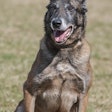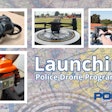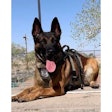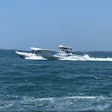 Photo courtesy of Defense Technology
Photo courtesy of Defense Technology
You want to be as prepared as possible to use less-lethal devices during call-outs. But if you could limit the cost and danger needed to train in their use, why wouldn't you? That's the idea behind Defense Technology's Low Roll Training Simulator Starter Kit. It contains everything an agency needs to instruct tactical team members in the use of flash-bangs in one portable package.
The heart of the kit is of course the Low Roll Training simulator itself. "It's based on a completely pneumatic operation, so there's no flame, heat, or spark involved," explains John Kapeles, category director of The Safariland Group's Defense Technology brand.
A real Defense Technology Distraction Device contains an explosive charge set off by a pyrotechnic fuse. The result is a loud sound, bright light, and significant overpressure. Defense Technology's Low-Roll Simulator, however, uses compressed gas to generate its sound.
"With no heat or overpressure, it's a much safer way to train when operators are first introduced to the concept of Distraction Devices," says Kapeles. "They can learn safe handling practices and the way to deploy them without the associated hazards of the real device."
But other than a lack of danger, the Low Roll Training Simulator is a very believable replica in fit, form, and function. It is the same size and weight as the real device so it feels the same and fits in all pouches and carriers. It also produces a very loud report to get tac teams used to continuing their mission despite the disruptive sound of a flash-bang. Another realistic feature is a pneumatic delay that activates when thrown to mimic the delay component of the actual device.
Beyond realism, these training simulators can provide a significant benefit when it comes to extending a law enforcement department's funding for training.
"It is very cost effective," says Kapeles. "Students in a class can deploy this multiple times and get very comfortable with the deployment and handling procedures at a small fraction of the cost of a single real device."
Other cost savings can be found in not needing to repair training facilities and being able to use free venues that might not allow true flash-bangs. "Because there is no hazardous material or pyrotechnic involved, there is no risk of damage to the surfaces where you're deploying it during training," notes Kapeles.
Defense Technology's Starter Kit also makes training in various settings easier because agencies can quickly fill and refill the simulators wherever the training is conducted.
"This is one of the features that makes the kit such a great training tool. You can reload it, start to finish, in less than 60 seconds," says Kapeles. To fill a simulator, you place the fuse handle onto the fuse body and secure it with a new pull ring. Then put the unit on top of the compressed gas cylinder with the regulator and fill tip in place. Hold the simulator body down for about five seconds until it's filled, and then screw a new end cap onto the bottom of the simulator body.
The starter kit comes in a case that holds the reusable components—compressed gas cylinder, simulator bodies, fuse heads, fuse handles, and a pressure regulator and fill tip to refill the bodies—and the consumable components—the pull rings and endcaps used to generate the sound output of the device—which can be reordered. You can also order additional simulator bodies and a maintenance kit for the fuse heads and fuse handles.
Departments don't like to sacrifice realism in training, but they can't always afford to use the real thing," Kapeles says. "I think Defense Technology's Low Roll Training Simulator Starter Kit really helps to solve that issue for agencies using Distraction Devices."


















